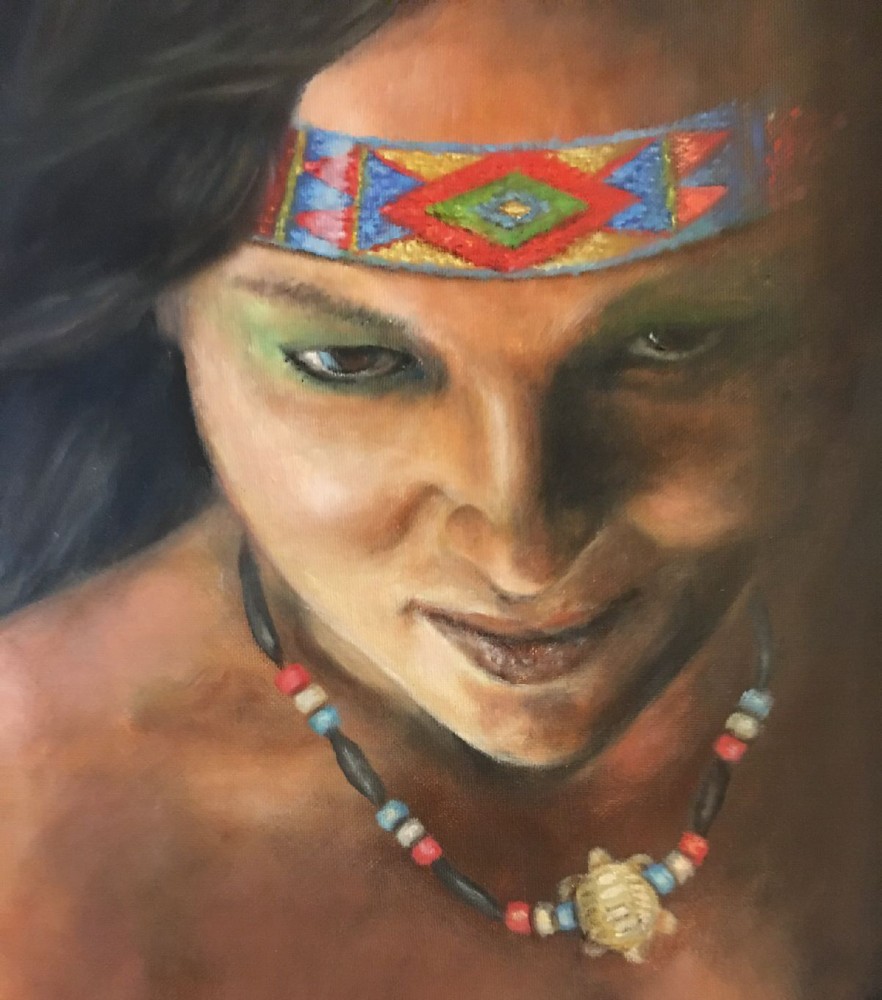
The future of Lakeview Village could be saved by our Indigenous past
This article was originally published December 7, 2019.
“There’s good and bad in Injun,
An’ thar’s good and bad in White;
But, somehow they is allus wrong,
An’ we is allus right"
- John E. Logan, The Injun, 1915
This old poem makes use of the word Injun, now considered a pejorative. The saving grace is that the poet uses it in jest – mocking the white man’s slanted view of Indigenous people. His poem steers clear of the more hated S-word (savages) which infests the writings of our first Prime Minister, John A. Macdonald, and our world-famous humourist, Stephen Leacock.
“When the school is on the reserve, the child lives with its parents, who are savages; he is surrounded by savages, and though he may learn to read and write, his habits and training and mode of thought are Indian. He is simply a savage who can read and write.”
- Macdonald, House of Commons, May 9, 1883
“The Indians of the West of fifty years ago were not like the humble quarter-breeds of the Ontario reservations, gratified with a red shirt and drunk on one drink of whisky. These latter had long since sold out savagery at ten dollars a year.”
- Leacock, Canada: The Foundations of Its Future, published 1944
These men amplified a long-held belief that our natives were either less-than-human, or babes in the woods, ill-mannered or ill-equipped to compete in a world based on the tenets of British imperialism and Christian forbearance. They also ignore our history, and the role played by the European settlers in the demise of our First Nations.
First came the import of white man’s diseases, especially smallpox.
Result: medical genocide.
Then natives were denied the means to fish from waters polluted by industry, or feed off the buffalo herds exterminated by white hunters.
Result: nutritional genocide.
Then bad treaties, enacted on questionable law and racial animus, led to the reserve system which, until 1961, refused natives the right to vote.
Result: political genocide.
Finally, came the greatest crime of all, residential schools.
This repudiated our aboriginals the fundamental right to be themselves. Shame and blame were heaped upon them simply because of who they were. Cut your hair. Change your clothes. Attend our schools. Worship our God. They weren’t to be trusted to raise their own children. To be fully human, their children had to have the Injun knocked out of them.
Result: cultural genocide.
So, where are we today? On January 8, 1998, our Minister of Indian Affairs and Northern Development delivered a written apology to the grand chief of the Assembly of First Nations. The government spent $350 million “for community-based healing as a first step to deal with the legacy of physical and sexual abuse at residential schools.”
A more fulsome apology followed in 2008 when Prime Minister Stephen Harper said: “The treatment of children in Indian Residential Schools is a sad chapter in our history. The legacy… has contributed to social problems that continue to exist in many communities today.” A Truth and Reconciliation Commission spent $72 million between 2007-15 to see and hear from 6,500 witnesses.
Result: A vast shaking of the country’s soul, and Ottawa recognizing this as a crime against humanity.
Justin Trudeau replaced Harper in ’15 and was voted in on a wave of goodwill. His “Sunny Days” mantra promised to re-right past wrongs – to improve on Harper’s reach out to our Indigenous people. Heck, a regional chief of the B.C. Assembly of First Nations, Jody Wilson-Raybould, was named our justice minister. Then came the Liberal’s $4.5 billion purchase of the Trans-Mountain pipeline and a determination to ship crude from the Alberta Oil Sands through eco-sensitive aboriginal lands in the B.C. interior and even more sensitive lands and water along the coast. It would be done in the spirit of economic development, a win-win. Meanwhile, Wilson-Raybould was embroiled in the SNC-Lavalin affair and ousted from Trudeau’s cabinet for having the temerity to stand up against a blatant attempt by the PM’s office to influence the judicial process in favour of a Quebec-based engineering firm with a long history of illegal behaviour.
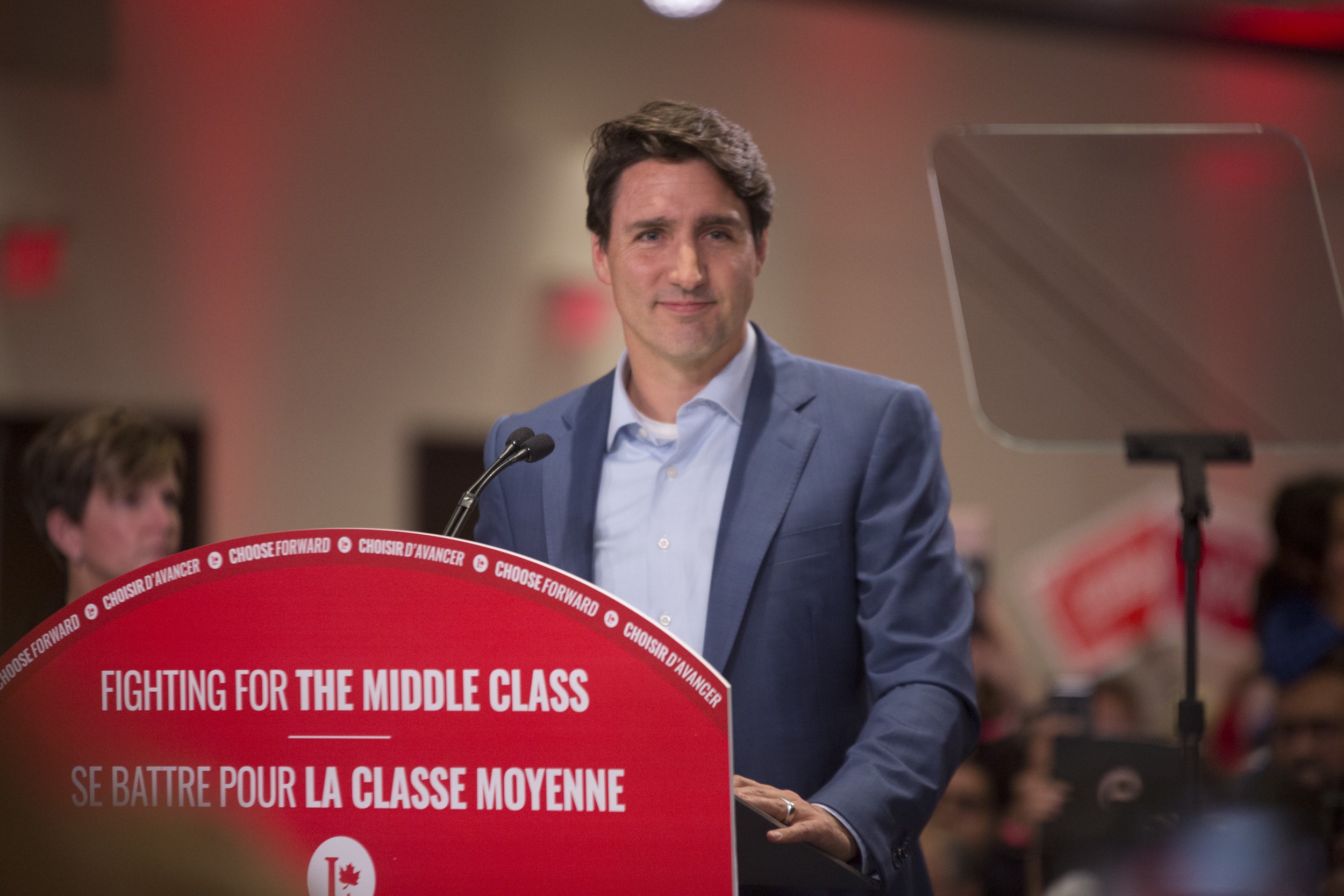
Prime Minister Justin Trudeau
A federal judge later blocked the Liberal government’s attempt to pause the compensation process for thousands of First Nations children deemed to have suffered racial discrimination through underfunded social services. The Canadian Human Rights Tribunal will proceed even as the liberals seek to get it struck down in court. This past week, Wilson-Raybould said the parties should have reached an agreement by now. This does not build trust, or reconciliation, she said. “There’s been ample time to do it and to recognize that we are talking about kids.”
The national chief of the Assembly of First Nations is calling on the federal government to create a national suicide-prevention strategy for young people, as a crisis currently grips a First Nation in North Saskatchewan. And this past week, the chief of Grassy Narrows First Nation in northern Ontario is accusing the Liberal government of stalling on a treatment centre for mercury poisoning, an issue of contamination that has plagued the people living near Dryden, Ont. since a paper mill dumped mercury into the English-Wabigoon River system as far back as the 1960s.
Our Indigenous learned long ago to live with the circumstances presented to them. Their journey to inner reconciliation has had some decidedly mixed results. Life on many reserves is horrid, Third World at best. Drugs and alcohol abuse is rampant. Sex traffickers recruit Indigenous girls fresh off the reserves. Infant mortality rates are double the world-wide average. TB is at epidemic proportions, and dire suicide statistics sit leaps and bounds above the national average. The dropout rate in high schools is over 50 percent. And a majority of aboriginal children are in care, mostly foster care.
These realities might discourage most people, but Barry Gilbert, president of the Eagle Spirits of the Great Waters, is energized.
The group was recently formed to work with members to get an Indigenous Village built on the massive mixed-use project soon to rise on the Ontario Power Generation (OPG) lands in Lakeview. He leads a group of educators and activists with one goal in mind: to re-right past wrongs.
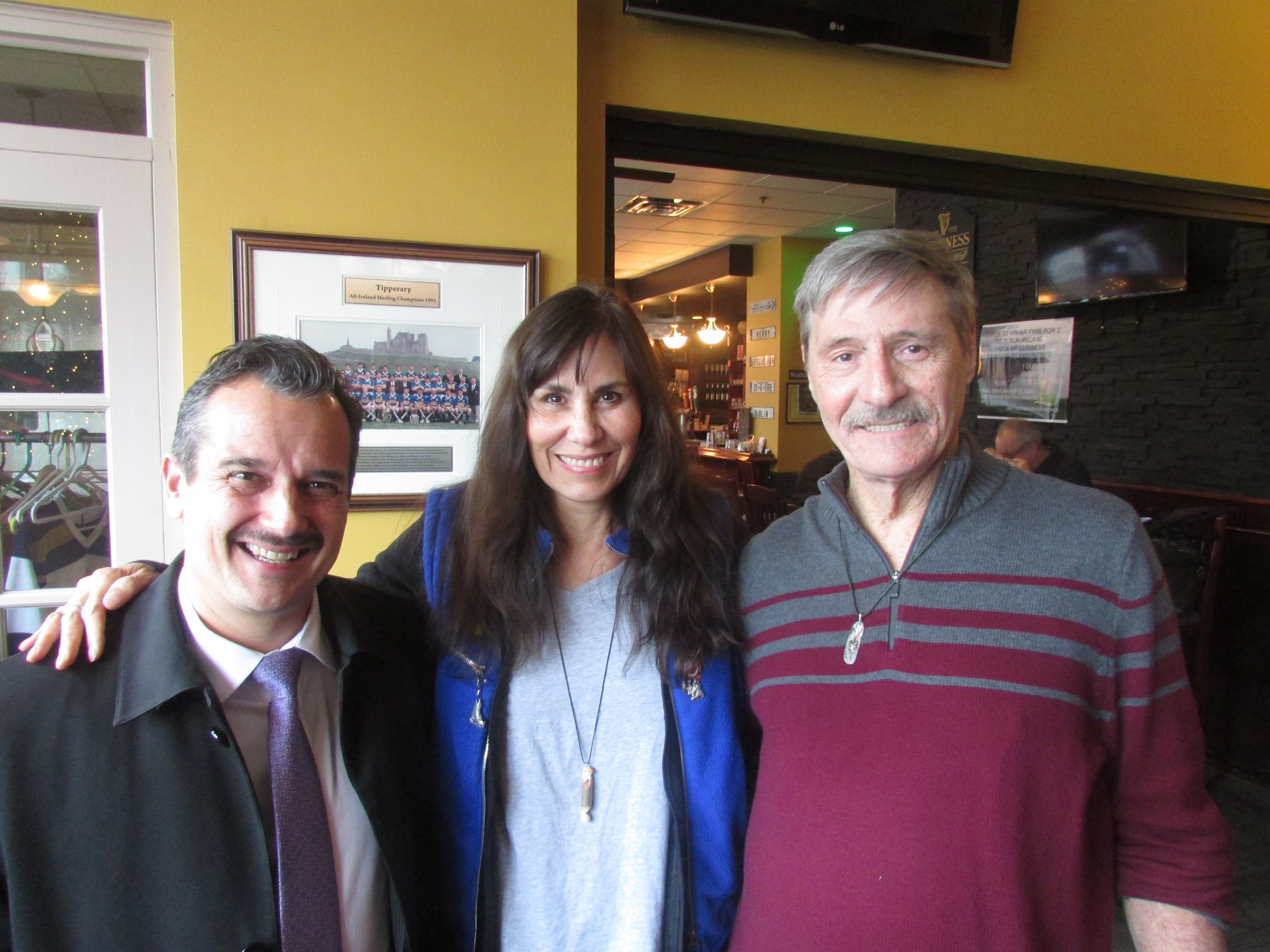
Barry Gilbert (right) alongside Ward 1 councillor Stephen Dasko and Lynn Taylor with Eagle Spirits of the Great Waters Arts and Cultures.
But a new set of circumstances is working itself out on the shores of Lake Ontario, in Lakeview. A consortium of private-sector developers, purchased the former OPG lands and will build a massive mixed-use Lakeview Village on this former lands of the Mississaugas. It’s a multi-billion-dollar scheme that has evolved from humble beginnings to a more robust development (aka, vertical sprawl). It will feature much taller condos abutting the lake. The 4.0 version is almost double the size from the original plan, and is sure to fill their pockets with what could amount to billions of extra dollars.
What it won’t do is make happy those from Eagle Spirits, or the Lakeview Residents Association, or the supporters of late Ward 1 councillor Jim Tovey who long-ago conceived an award-winning, people-friendly Lakeview Village plan that was sublime in concept, and built to “human scale.” One of the elements was an Indigenous Village and Arts Walk to pay homage to the natives who once hunted, fished, and lived on this bucolic land.
So, let the truth and reconciliation begin, right?
But wait. This Indigenous village plan has been scuttled.
This has lit a fire under Gilbert and the other stakeholders. He told The Pointer that he will never be silenced again. “It’s important that we bring the truth forward,” he said. “We have to talk about healing and move on to truth and reconciliation.”
The idea is to “educate people on everything about the history.” In the end, he said, “we’re [as a people] not going anywhere.”
Over 200 people gathered at the Army, Navy & Air Force Veterans Club in Lakeview a few weeks back to see the latest proposal for the redevelopment of Lakeview, the 4.0 model. The original concept powered by residents was called Inspiration Lakeview. It has disappeared. A key was to herald the return of the Lakeview shoreline, with designated parks and leisure space by the water. It was 14 years from conception to the last one. At the meeting, residents were allowed to unpack their hearts. When Ward 1 councillor Stephen Dasko told attendees he was not and had never been “a proponent of high rise on the waterfront”, the applause was sustained, but perhaps tinged by a sense of determinism. Is the fix in?
Eagle Spirits know the Lakeview Partners have added a small building on the edge of an area that was previously earmarked for its Indigenous education centre and village, along with an art walk and a water testing facility.
The chance to fix a historic wrong, and seek truth and reconciliation for a people who were abused and almost erased, is still a possibility, however slight. Said Gilbert: “We can talk about healing, but we can’t heal until we start bringing non-Indigenous in to engage and learn about other cultures. We need to learn about each other’s ways. Building this [Iindigenous cultural centre and village] is a beautiful opportunity.”
An opportunity lost, if the current plan remains in place.
If it looks like council and the private-sector has abandoned the aboriginals, one institute of higher learning hasn’t, the University of Toronto. It has offered up $2,000 and a Fellowship Program (designating three students) to take up the fight, and study the issue. It’s a tiny amount, but symbolically significant, and extends the argument that building a project that links past, present and future, meets goals set out in the tenets of truth and reconciliation. That this project has found currency with academia, might suggest we’re at the beginnings of David vs. Goliath battle, which gains more resonance because Mississauga is at the crossroads in its development history.
Gil Penalosa, a famed urbanologist, said during a recent speech in Port Credit, Mississauga is at a pivot point in urban development. He made it clear that the city has just one chance to get it right when it comes to its waterfront. He said the city needs an identifier, something that makes it the envy of other cities in Canada and across the world. Vertical sprawl doesn’t cut it, especially when located on pristine property that isn’t renewable, like lakefront.
A forest of condos like those that now block views of Lake Ontario on the ride in to Toronto, isn’t anyone’s answer of positive future growth. Mississauga can be redefined “as a place to go, a tourist draw, with an opportunity for world-class attention,” he said.
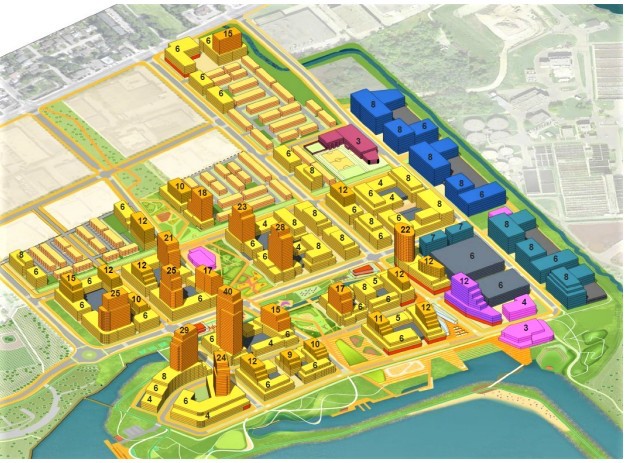
The latest proposal for Lakeview.
This is the city’s “woke” moment.
“When you say no to something, you say yes to something else,” said Penalosa. “Act as if you are at a crossroads – because you are.”
Gilbert is passionate about the Aboriginal Village idea, and still hopeful because at meetings, his group has rallied support from the local ratepayers’ association, the Lakeview Small Arms Society, the Town of Port Credit Community Association (TOPCA), the local BIA, current Ward 1 councillor Dasko, and Mississauga-Lakeshore MP Sven Spengemann, among others.
He was a friend and colleague of late Ward 1 councillor Jim Tovey, and both shared the same dream: constructing a bridge between past and future generations through an Indigenous Village.
The original plans for a new-look Lakeview Village won awards as the first community driven redevelopment plan in North America.
The next iteration, Imagination Lakeview, was to build a mixed-use village with a reasonable density, leaving open vistas of the lake. The blunt 4.0 rendition of the Lakeview Partners’ plan, throws these original schemes on the dust pile.
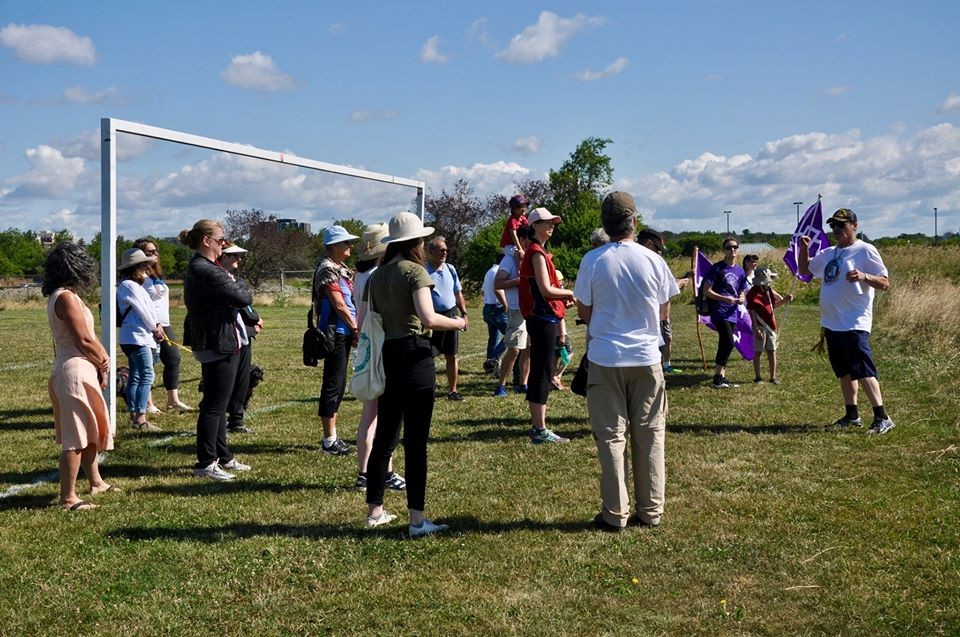
Gilbert (right) hosts a Walk and Talk event along the Mississauga waterfront to help educate residents about the history of the area.
On Dec. 18th, at the Army, Navy and Air Force (ANAF) club on Third Street in Lakeview, Mayor Bonnie Crombie will meet with the Indigenous community. The hope is that the final project will be built to “human scale” with a small percentage saved as a reach to our Indigenous past. Right now, the odds are clearly stacked against Eagle Spirits and their supporters. It’s become clearer that a massive redevelopment project on irreplaceable waterfront lands, to house another over-built condo development, is exactly what’s not needed here. In fact, the Indigenous village idea and arts walk, doesn’t look bold, or large enough. The chance remains to turn this land into a gathering place for all.
The B.C.-based Indigenous Tourism Association of Canada (ITAC), says this tourism has grown by $300 million between 2014 and 2017. It now totals $1.7 billion, including the creation of over 7,000 jobs. Overall Indigenous tourism was up by 23 percent, far above the national average. “One in three visitors to Canada are interested in an authentic Indigenous tourism experience,” Keith Henry, ITAC president, told CBC News.
How about creating it in the biggest market in Canada, the Greater Toronto Area? If done right, it would put Mississauga on the map and be our first great identifier – something this city has long lacked.
The results could be monumental for a city that was originally built around a mall. We could be home to something that reflects the very tenets of the Truth and Reconciliation commission.
This village would be built and operated and used as a centre of learning for all Indigenous peoples, a self-sufficient profit-generator to fund social programs to help pull others out of their current plight on reserves across the land. The fact it would create jobs, and act as a draw for Indigenous art, and educational opportunities, adds to its lustre, its rightness. It’s the kind of bold plan that this city has lacked from its inception.
The new Lakeview Village Master Plan is an affront to this city’s natural order. In its early inception, it foresaw a village that reclaimed the waterfront and would serve the needs of future generations, a special place, a different place. But the developers found ways to maximize profits by upping density, and the city looks like it is now stuck with a ho-hum project featuring a forest of condos on its shoreline.
The chance to be different, isn’t lost yet, and a new Indigenous Village would be an artful add-on, one that should be embraced by the Lakeview Partners. Being closely tied to the nearby Jim Tovey conservation area, this one-two punch would create the prospect of a massive influx of tourism, more community buzz and involvement, and even drive up land values for those eager to buy condo units on the site. It will also create a community hub, and increase the need for more public transit.
It would create a totem, so to speak, a spirit being, a sacred object, and serve as a symbol or emblem for a city now devoid of one.
It simply makes fiscal, moral, sociological, civic, and historical sense.
If there is a chance to get development in Mississauga right, this seems a composite drawing, the true definition of a win-win.
If those ruling in Ottawa, Queen’s Park, or city hall, believe that it’s truly time for truth and reconciliation, then they should put their money where their good intentions are. It’s time that all the stakeholders from Eagle Spirits to the Lakeview Partners, work in concert.
When Penalosa was here, he did a shout-out to Mississauga. Through The Pointer, he told the city: “Don’t be shy. Be bold!”
He might have added: dare to be great.
The 4.0 version of the plan for the Lakeview waterfront isn’t great. It’s non-descript, over-built, and exemplifies the worst elements of development excesses.
Cities with confidence don’t allow profit-driven developers setting their land-use agenda.
Cities with confidence, don’t give up their pristine waterfront to the highest bidder.
The Eagle Spirits of the Great Waters is a tiny group, underfunded but not underappreciated. Its membership is passionate, and wants truth and reconciliation to work its wonders on our shoreline. They are eager to connect past and present and build something that will play a part in our children’s future.
Past wrongs took place because of racist settlement practices. The newcomers tossed out the people who lived and dreamed and raised their families here.
The 4.0 version of past injustices is now working itself out before our eyes.
This new development consortium recently consigned the idea of an Indigenous village to the sidelines in favour of its own one.
The decision was abrupt, but followed a well-worn historical pattern.
Gilbert vows that those who had the Injun knocked out of them, will never be silenced again.
Submit a correction about this story


